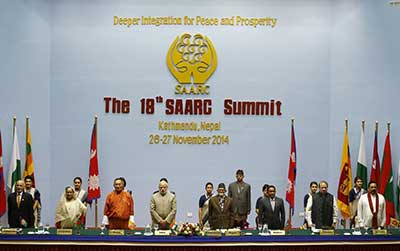Date: 09/12/2022
Relevance: GS-2: Bilateral, Regional, and Global Groupings and Agreements involving India and/or affecting India’s interests.
Key Phrases: South Asian Association for Regional Cooperation (SAARC), South Asian University (SAU), Bay of Bengal Initiative for Multi-Sectoral, Technical, and Economic Cooperation (BIMSTEC), ASEAN Minus X’ formula, flexible ‘BIMSTEC Minus X’ formula.
Why in News?
- December 8 is commemorated as SAARC Charter Day and it was on this day, 37 years ago, that the South Asian Association for Regional Cooperation (SAARC), an intergovernmental organization, was established by Bangladesh, Bhutan, India, the Maldives, Nepal, Pakistan, and Sri Lanka to promote economic growth in South Asia. Afghanistan acceded to SAARC later.
Failure of SAARC:
- SAARC has failed abjectly in accomplishing most of its objectives.
- South Asia continues to be an extremely poor and least integrated region in the world.
- The intraregional trade and investment in South Asia are very low when compared to other regions such as the Association of South East Asian Nations (ASEAN) and Sub-Saharan Africa.
- Pakistan has adopted an obstructionist attitude within SAARC by repeatedly blocking several vital initiatives such as the motor vehicles agreement, aimed at bolstering regional connectivity.
- Deepening hostility between India and Pakistan has made matters worse. Since 2014, no SAARC summit has taken place leaving the organization rudderless, and practically dead.
Significance of regionalism:
- ‘Neighbourhood first’ policy:
- South Asia, which is India’s neighbourhood, is important for India’s national interests. This is best captured in the current government’s ‘neighbourhood first’ policy.
- SAARC is the only intergovernmental organization with a pan-South Asia reach. India can judiciously employ it to serve its interests in the entire region.
- Stability of the other institutions:
- India, in the last few years, has been looking at SAARC through the lens of Pakistan. Consequently, the deterioration in India-Pakistan relations has coincided with the incapacitation of SAARC, much to the delight of Pakistan.
- A weakened SAARC also means heightened instability in other promising regional institutions such as the South Asian University (SAU), which is critical to buttressing India’s soft power in the region.
- Bilateralism as substitute of regionalism:
- A new narrative is that in South Asia, India can successfully use the instrument of bilateralism over regionalism to pursue its interests.
- While bilateralism is undoubtedly important, it can at best complement, not substitute, regional or multilateral efforts.
- Success of ASEAN:
- Regionalism has brought immense success in other parts such as East Asia and Africa.
- Looking at ASEAN’s spectacular success in regional integration, experts have developed the concept of a new regional economic order — a process through which developing countries search for a trade-development model, based on incrementalism and flexibility; this is different from the neoliberal model laid down by the Washington Consensus.
- Weakening multilateralism:
- Regionalism can deliver prosperity in the South Asian region too, especially because multilateralism is weakening.
The BIMSTEC Promise:
- Since South Asia cannot repudiate regionalism, reviving SAARC by infusing political energy into it and updating its dated Charter will be an ideal way forward. However, in the current scenario, this is too idealistic.
- So, the next best scenario is to look at other regional instruments such as the Bay of Bengal Initiative for Multi-Sectoral, Technical, and Economic Cooperation (BIMSTEC), an intergovernmental organization established in 1997.
- BIMSTEC comprises five South Asian nations (Bangladesh, Bhutan, Nepal, India, and Sri Lanka) and two ASEAN countries (Myanmar and Thailand). Importantly, Pakistan is not a BIMSTEC member.
- In recent years, India seems to have moved its diplomatic energy away from SAARC to BIMSTEC. This resulted in BIMSTEC, after 25 years, finally adopting its Charter earlier this year.
- The BIMSTEC Charter is significantly better than the SAARC
Charter.
- For instance, unlike the SAARC Charter, Article 6 of the BIMSTEC Charter talks about the ‘Admission of new members’ to the group. This paves the way for the admission of countries such as the Maldives.
Need for a flexible participation scheme:
- Notwithstanding the improvements, the BIMSTEC Charter, to boost economic integration, does not contain the flexible participation scheme of the kind present in the ASEAN Charter.
- This flexible scheme, also known as the ‘ASEAN Minus X’ formula, allows two or more ASEAN members to initiate negotiations for economic commitments.
- Thus, no country enjoys veto power to thwart economic integration between willing countries.
- Given the experience of SAARC, where Pakistan routinely vetoes several regional integration initiatives, it is surprising that BIMSTEC does not contain such a flexible participation scheme.
- A flexible ‘BIMSTEC Minus X’ formula might have allowed India and Bangladesh or India and Thailand to conduct their ongoing bilateral free trade agreement (FTA) negotiations under the broader BIMSTEC umbrella.
- This would have eventually strengthened BIMSTEC by enabling the gradual and incremental expansion of these binding commitments to other members. India should press for this amendment in the BIMSTEC Charter.
Conclusion:
- BIMSTEC should not end up as another SAARC. For this, its member countries should raise the stakes.
- A high-quality FTA offering deep economic integration — something that Prime Minister advocated at the last BIMSTEC ministerial meeting — would be an ideal step.
- Likewise, India should explore legal ways to move successful SAARC institutions such as SAU to BIMSTEC.
- These steps will give stronger roots to BIMSTEC and enable erecting of a new South Asian regional order based on incrementalism and flexibility, ushering in prosperity and peace in the region.
Source: The Hindu
Mains Question:
Q. How can focusing on regional instruments such as BIMSTEC play a better role in improving regional multilateral cooperation than the revival of SAARC in the current scenario? Discuss.






















